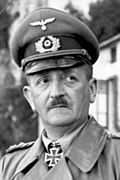History
The 15th Army was activated in occupied France on 15 January 1941 with General Curt Haase in command. It was tasked with occupation and defensive duties in the Pas de Calais area.
The Allies landed further west, in Operation Overlord, during June 1944. Afterwards, the 15th Army was withdrawn to the Netherlands, where it fought the Allies during Operation Market Garden in September 1944.
It suffered defeat against the First Canadian Army in the Battle of the Scheldt during which the Army Headquarters at Dordrecht was subject to a mass attack by Hawker Typhoons of the Second Tactical Air Force on 24 October 1944. Two generals and 70 other staff officers were killed in the attack. [1] . According to a Dutch documentary there were 69 civilian casualties and some German casualties, but not any of the staff officers. [2]
During October 1944 the 15th Army continued to resist against the Canadian First Army and British Second Army as they pushed west from the Nijmegen/Eindhoven salient in Operation Pheasant.
The British Second Army cleared the 15th Army from the Roer Triangle during Operation Blackcock, pushing it back over the Rur and Wurm rivers. It was involved in the Battle of Hurtgen Forest before finally surrendering along the Ruhr river in 1945.
Today, the former HQ of the 15th Army, in Tourcoing, which is just north of Lille in France, is a museum: Museum of 5 June 1944.
This page is based on this
Wikipedia article Text is available under the
CC BY-SA 4.0 license; additional terms may apply.
Images, videos and audio are available under their respective licenses.




